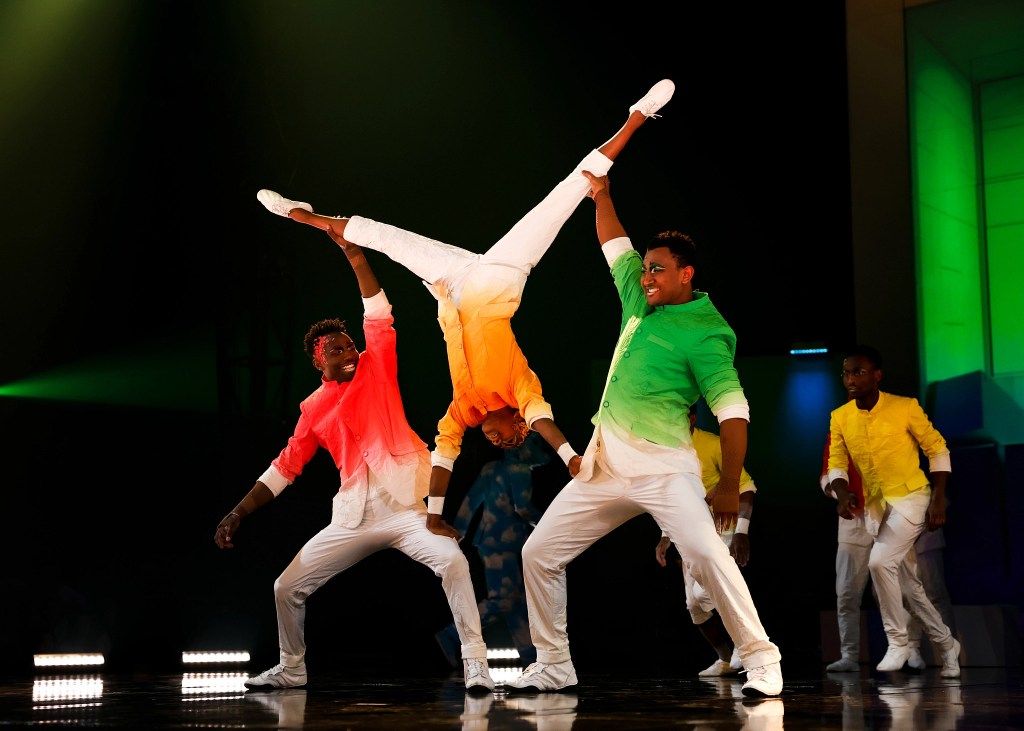Acrobats catapult through the air, whirling around a colossal white cube wearing sculptural animal masks and street style-inspired tailored suiting. Cirque du Soleil’s 20th big top production, Echo, which premiered this fall in the U.S., showcases gravity-defying feats of the human body. Weaving together a storyline about relationship between humans and animals, Echo is the company’s first new show since the pandemic. And the creators have come back with a completely refreshed style, a streamlined minimalist feel that makes the stage a runway for polished, high performance fashion.

Costume designer Nicolas Vaudelet
courtesy
The show’s two central groups of characters are paper animals and paper people. Costume designer Nicolas Vaudelet created suits in white fabric made to resemble crumpled paper — a huge departure from Cirque’s usually more ornate style.
The symbolism is subtle. The fabric’s wrinkles, he said, give the feel that these characters’ lives are still being crafted. Pops of fluorescent color differentiate the humans from the animals. All of the acts are performed on a stage with video projections of nature, fire and a band of live vocalists, creating an effect that is cool and more relatable.
Vaudelet started his career in haute couture. He has worked with fashion houses including Alexander McQueen, Christian Lacroix and Jean-Paul Gaultier, with whom he developed the costumes for Madonna’s “Confession” tour. But circus, he says, is a totally different world. “In couture you can do a lot, but in circus you can do even more. We don’t have limits on creativity.”

courtesy
And as a costume designer, he added, he can also take more time to create. Echo’s production was halted in 2020 due to the pandemic. Vaudelet used that period to reflect and refine. “We never stopped working. I would say the costumes have been four years in the making.”
Production resumed in 2022 and the show was finally unveiled for the first time in Montreal, last spring, where the company is headquartered. It has been the highest selling show to premier in the history of Cirque du Soleil.
At their headquarters in Montreal, Cirque’s atelier and wardrobe department is made up of a team of more than 200 employees who work on the research and development for all of the company’s shows. This includes milliners, shoemakers and wigmakers. Costumes are all created in house from beginning to end, including developing fabrics.
“The shape and pattern of a look may seem simple, but in a circus world, there are a lot of details and technicalities behind every detail,” said Vaudelet. “A lot of research that goes into it.”
For Echo, Vaudelet spent a great deal of time developing the textured fabric for the suits, which acrobats wear as they perform some of the company’s most complicated maneuvers. The design team developed a thin but strong polyester treated to be matte with stretchability that allowed for the acrobats to move freely.
The material also had to go through several tests for durability so it can withstand the rigor of 10 shows a week.
Another big design challenge for Vaudelet was putting acrobats in full head coverings. The teeter board artists wear animal headpieces while propelling through the air on narrow boards, one of the most dangerous acts to pull off. “We have to make sure their vision is never compromised in any way,” Vaudelet said. The headwear is developed using medical grade materials to ensure they are lightweight and stay in place throughout the complex movements.

courtesy
“Montreal is like a big laboratory. We do a lot of testing,” Vaudelet explained. Printing on white fabric with bright colors, such as the neon orange used in the show, led to unanticipated issues. “We washed it and the orange bled all over. So this type of simple thing took a lot of trial and error.”
The footwear for the show is created by Cirque’s own shoemakers or purchased from athletic footwear brands like Asics and New Balance. Those are then modified with covers so the original shoe is not visible.
The atelier also uses 3D printers to make everything from the buttons, to show props.
Because the costumes for the shows have to remain consistent as they tour around the world, creating everything in house ensures the best results. A library in the atelier catalogues the tens of thousands of fabrics and colorways created over the years.

courtesy
“The magic is we are working for a show, we are not selling any of this. We just want beautiful silhouettes and characters. That’s the difference between traditional fashion and costumes. We are not presenting a collection for buyers,” Vaudelet said. “We want to create characters that look beautiful on a stage and together tell a story. Echo is a show that should make you feel like you’re are walking in a dream.”
After the U.S. premier in Washington, D.C., the Echo big top will move to the Miami area at the end of October, followed by four other cities this year.

